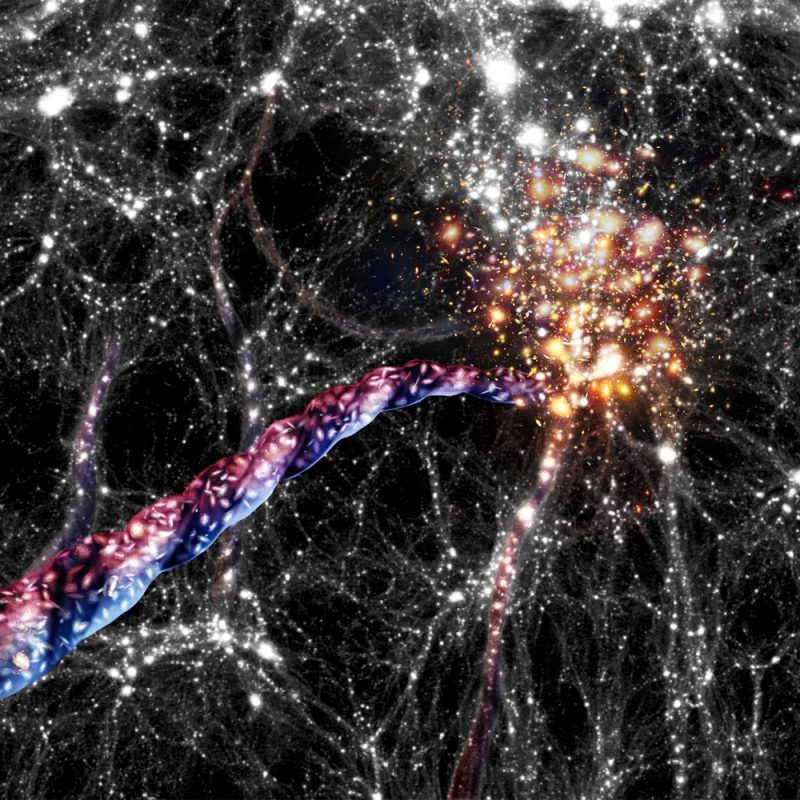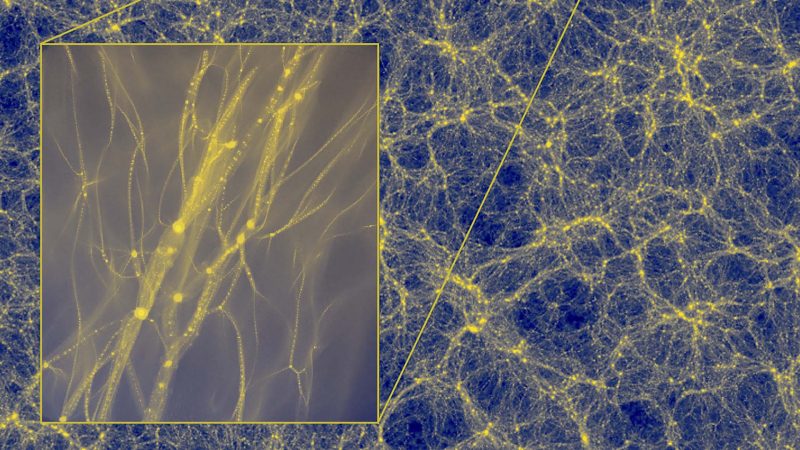
Filaments of the cosmic web
Astronomers at the Leibniz Institute for Astrophysics Potsdam, in collaboration with scientists in China and Estonia, said on June 14, 2021, that they’ve discovered a rotation – a spin – on an enormous scale never seen before. They made the discovery by mapping the motion of galaxies in huge filaments or strands of what’s called the cosmic web. They were looking at the universe on the grandest scale, in which there are great filaments made of galaxies, separated by giant voids. And they found that these long tendrils of galaxies and matter, forming the vast cosmic filaments of the cosmic web, rotate on the scale of hundreds of millions of light-years.
It’s the largest rotation in the universe, these astronomers said.
You know how ice skaters spin faster as they pull in their arms? Scientists describe that faster spin as due to conservation of angular momentum. These astronomers said their results:
… signify that angular momentum can be generated on unprecedented scales.
The study was published on June 14, 2021, in the peer-reviewed journal Nature Astronomy.
Largest rotation in the universe
So the cosmic filaments are essentially galaxy-packed bridges. And you might ask, from where to where? Astronomers say that vast clusters of galaxies lie at the nodes, or connection points, of the cosmic web. A cosmic filament made of galaxies – now known to be spinning – spans the vast distant between clusters of galaxies.
Noam Libeskind at the Leibniz Institute for Astrophysics Potsdam, initiator of the project, said that galaxies:
… move on helixes or corkscrew like orbits, circling around the middle of the filament while travelling along it. Such a spin has never been seen before on such enormous scales, and the implication is that there must be an as yet unknown physical mechanism responsible for torquing these objects.
He also described the filaments themselves as “thin cylinders:”
… similar in dimension to pencils, hundreds of millions of light-years long, but just a few million light-years in diameter.
And he added:
These fantastic tendrils of matter rotate. On these scales, the galaxies within them are themselves just specks of dust.

How do we know?
As Noam Libeskind said above, the galaxies in the filaments funnel on corkscrew paths into the clusters at their ends. Thus, to us on Earth, the light of the funneling galaxies appears red-shifted when moving away from us, and blue-shifted when moving toward us. Astronomers can measure a shift like that.
These astronomers measured red and blue shifts using existing data in the Sloan Digital Sky Survey, which began collecting data in 2000. Peng Wang of the Leibniz Institute for Astrophysics Potsdam explained:
By mapping the motion of galaxies in these huge cosmic superhighways using the Sloan Digital Sky survey – a survey of hundreds of thousands of galaxies – we found a remarkable property of these filaments: they spin.
What does it mean?
In hindsight, it’s logical to think that the filaments would spin. After all, there must have been a period during which – as the early universe expanded outward from the Big Bang, and as galaxies began to form – the galaxies for some reason pulled themselves into these vast filaments, creating the cosmic web in the first place. And, as they did so, it’s easy to think of the filaments spinning up, like ice skaters pulling in their arms.
In fact, it was earlier work by theorist Mark Neyrinck that caused these astronomers to analyze the Sloan Digital Sky Survey data. Libeskind said:
It’s fantastic to see this confirmation that intergalactic filaments rotate in the real universe, as well as in computer simulation.
The scientists still wonder, though, why do they spin? Or perhaps it’s better to ask the question as how. How is the angular momentum generated? What made the galaxies pull themselves together into filaments? Why does the universe appear as a cosmic web at all?

Bottom line: Astronomers have found the largest rotation in the universe by analyzing red and blue shifts in galaxies. The galaxies compose strands or filaments in the cosmic web. Those filaments are now believed to be spinning.
Source: Possible observational evidence for cosmic filament spin











